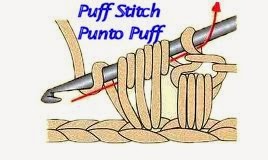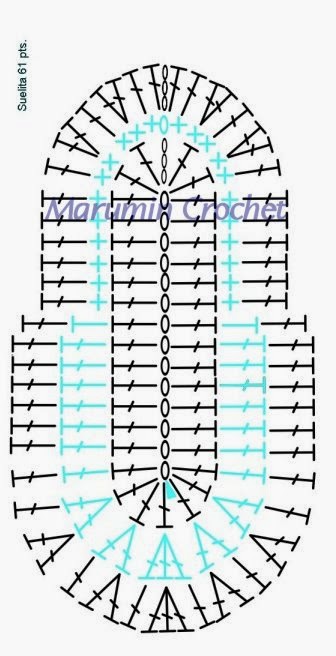Existen varios tipos de puntos abultados o en relieve, pero el efecto es similar... quedan como "bolitas" o "motitas" en el tejido. Los más comunes son Punto Puff, Punto Piña y Punto Bodoque (se encuentran en la web bajo diferentes nombres: garbanzo, motita, madroño, guisante, etc.) Todos se trabajan iniciando en un mismo punto de base y la diferencia principal entre ellos está en la forma en que se cierran.
Cluster stitches give interest and texture to your crocheted designs.
There are various types of cluster stitches, but they all have a similar effect... they create little "bobbles" in the crocheted fabric.
The most common cluster stitches are: Puff Stich, Bobble Stitch and Pop Corn (though some websites have different denominations for the same stitches). They are all worked by inserting the hook in the same base stitch or space, the main difference between them is the way in which the stitches are closed.
El Punto Puff, consiste únicamente de lazadas, que se cierran todas juntas de una sola vez. Algunas fuentes consideran el punto puff como la variante (a medio punto) del punto piña. A diferencia del punto piña y el punto pop corn ,este punto tiene una apariencia bastante parecida por el derecho y el revés del tejido.
A Puff Stitch consists of a series of loops closed all at once. Some sources consider the puff stitch to be the half double crochet version of the Bobble Stitch. This stitch looks fairly the same from both sides of the garment.
The Bobble Stitch consists of a number of stitches worked leaving the last loop of each stitch on the hook, and then closing all these loops together. It can be worked in groups of 3, 4 or 5 stitches, mainly double and triple crochet.
Para el Punto Pop Corn, se trabaja una cantidad de puntos en un mismo punto de base para luego retirar cuidadosamente el ganchillo de la última lazada, reintroducirlo al inicio del grupo, tomar la lazada que dejamos en suspenso y cerrar el grupo. Por lo general se trabaja en base a puntos altos, pero también se puede hacer con medio punto o punto alto doble o triple. Este punto tiene un derecho y un revés bien definidos.
For the he Pop Corn Stitch a number of complete stitches are worked into the same base stitch, the hook is carefully removed from the last loop and reinserted at the beginning of the group of stitches, then the last loop is reinserted in the hook and slip stitched through the other loop in the hook, thus forcing the stitches together, which makes them "pop". Usually Pop Corn stitches are made with double, half double or triple crochet. This stitch looks completely different from each side of the garment.
En la muestra se puede ver la diferencia del efecto que producen estos tres puntos
In the sample below you can see the difference between the three stitches
.JPG)



















